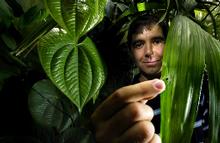Press Release
|
Laura Snider Camera Staff Writer |
Original source: www.dailycamera.com |
Boulder scientist's invention could save water, money
Chip lets plants ask for a drink

University of Colorado researcher Hans Seelig holds a small sensor, dubbed the SG1000, that he has developed to monitor the water stress of plants in his greenhouse. The sensor could help limit water waste, reduce energy demand and save farmers millions of dollars.
Photo by Joshua Lawton
Crops will be able to ask for a drink of water when they need it, thanks to an invention by a Boulder scientist.
A computerized sensor less than half the size of a ladybug will be able to monitor how thirsty a plant is when it's clipped to a leaf. The microchip ” originally designed with growing plants on Mars in mind ” will beam the information wirelessly to a computer, which can then turn on or off an irrigation system as needed.
Hans Seelig, the sensor's inventor and a researcher at the University of Colorado's BioServe Space Technology Center, said he hopes his invention will save farmers water, energy and money.
"If you allow the plant to regulate when the water is going to be applied, you are most likely going to save a day or two of watering over several weeks," said Richard Stoner, whose company, AgriHouse, is working to make Seelig's invention commercially available. "We believe we could save millions of dollars in energy and water."
Current irrigation practices rely heavily on farmers' green thumbs. Years of experience have given growers general rules to follow for how often crops such as corn, potatoes or sugar beets need to be watered. But the estimates often err on the safe side, and many fields end up over-watered, Seelig said.
Tensiometers, devices used to detect soil moisture, can also help farmers determine when to water crops. But soil moisture does not translate directly into a plant's need for water, and tensiometers can become inaccurate over time, agriculture experts say.
"Research has determined that the plant uptakes the water when the plant wants to, not when the farmer thinks the plants should be watered," Stoner said.
In 2000, Colorado farmers irrigated 3.4 million acres of land with 11.4 billion gallons of water a day ” more than one and a half times the amount of water the city of Boulder delivers to its customers in a year ” according to the U.S. Geological Survey. Irrigation costs in the state top $100 million a year, with half that paying the energy bill for pumping the water out to the fields.
And even if the price tag didn't concern farmers, the future availability of water probably does. As Colorado's population continues to balloon ” the U.S. Census Bureau projects that the state's population will hit 5.8 million by 2030 ” so does the demand for water.
Most of the water that flows through Colorado is already claimed, either by residents or by other states that lie downstream. Sixty-five percent of the available water in the South Platte River is used for agriculture, and Colorado had to pay $30 million to Kansas in 2002 for using too much of the Arkansas River before it flowed east.
Seelig said he hopes his new chip, now called the SG1000, can bring precision to irrigation with only a handful of sensors scattered across an entire field.
The chips are being tested in a CU greenhouse on a few potted cowpea plants, but Berthoud-based AgriHouse has just received a grant from the National Science Foundation to research the chips on a large scale. Still, AgriHouse doesn't expect to sell the chip for another three to five years.
The plant sensor also has potential applications in space. In fact, Seelig's inspiration for the microchip grew out of a desire to figure out how to grow greenhouse plants on Mars with the least amount of water. But in the process, Seelig realized how beneficial the technology could be right here in the arid West.
"If you look at climate change, it's only supposed to get drier," Seelig said. "So it's not only good for right now, it will be good for the future."